

| Visitors Now: | |
| Total Visits: | |
| Total Stories: |

| Story Views | |
| Now: | |
| Last Hour: | |
| Last 24 Hours: | |
| Total: | |
Why The Arctic Sea Ice Death Spiral Matters
By Neven Acropolis & Kevin McKinney
02 September, 2012
Climate Progress
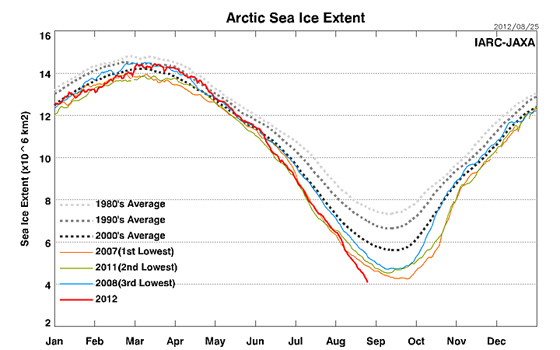
Arctic sea ice extent takes a nosedive this year. What does it mean for us? (Source: Japan Aerospace Exploration Agency)
In the past week the Arctic sea ice cover reached an all-time low, several weeks before previous records, and several weeks before the end of the melting season. The long-term decline of Arctic sea ice has been incredibly fast, and at this point a sudden reversal of events doesn’t seem likely. The question no longer seems to be “will we see an ice-free Arctic?” but “how soon will we see it?”. By running the Arctic Sea Ice blog for the past three years I’ve learned much about the importance of Arctic sea ice. With the help of Kevin McKinney I’ve written the piece below, which is a summary of all the potential consequences of disappearing Arctic sea ice.
Arctic sea ice became a recurrent feature on planet Earth around 47 million years ago. Since the start of the current ice age, about 2.5 million years ago, the Arctic Ocean has been completely covered with sea ice. Only during interglacials, like the one we are in now, does some of the sea ice melt during summer, when the top of the planet is oriented a bit more towards the Sun and receives large amounts of sunlight for several summer months. Even then, when winter starts, the ice-free portion of the Arctic Ocean freezes over again with a new layer of sea ice.
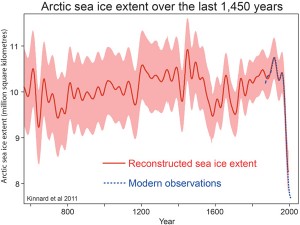
Arctic sea ice extent reconstruction – Kinnard et al. 2011
Since the dawn of human civilization, 5000 to 8000 years ago, this annual ebb and flow of melting and freezing Arctic sea ice has been more or less consistent. There were periods when more ice melted during summer, and periods when less melted. However, a radical shift has occurred in recent times. Ever since satellites allowed a detailed view of the Arctic and its ice, a pronounced decrease in summer sea ice cover has been observed (with this year setting a new record low). When the IPCC released its Fourth Assessment Report in 2007, it was generally thought that the Arctic could become ice-free somewhere near the end of this century. But changes in the Arctic have progressed at such speed that most experts now think 2030 might see an ice-free Arctic for the first time. Some say it could even happen this decade.
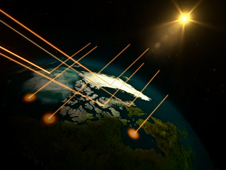
Sea ice albedo feedback – NASA
What makes this event significant, is the role Arctic sea ice plays as a reflector of solar energy. Ice is white and therefore reflects a large part of incoming sunlight back out to space. But where there is no ice, dark ocean water absorbs most of the sunlight and thus heats up. The less ice there is, the more the water heats up, melting more ice. This feedback has all kinds of consequences for the Arctic region. Disappearing ice can be good for species such as tiny algae that profit from the warmer waters and extended growing season, but no sea ice could spell catastrophe for larger animals that hunt or give birth to offspring on the ice. Rapidly changing conditions also have repercussions for human populations whose income and culture depend on sea ice. Their communities literally melt and wash away as the sea ice no longer acts as a buffer to weaken wave action.
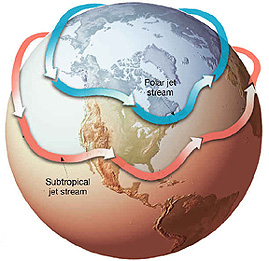
Polar jet stream – NC State University
But what happens in the Arctic, doesn’t stay in the Arctic. The rapid disappearance of sea ice cover can have consequences that are felt all over the Northern Hemisphere, due to the effects it has on atmospheric patterns. As the ice pack becomes smaller ever earlier into the melting season, more and more sunlight gets soaked up by dark ocean waters, effectively warming up the ocean. The heat and moisture that are then released to the atmosphere in fall and winter could be leading to disturbances of the jet stream, the high-altitude wind that separates warm air to its south from cold air to the north. A destabilized jet stream becomes more ‘wavy’, allowing frigid air to plunge farther south, a possible factor in the extreme winters that were experienced all around the Northern Hemisphere in recent years. Another side-effect is that as the jet stream waves become larger, they slow down or even stall at times, leading to a significant increase in so-called blocking events. These cause extreme weather simply because they lead to unusually prolonged conditions of one type or another. The recent prolonged heatwave, drought and wildfires in the USA are one example of what can happen; another is the cool, dull and extremely wet first half of summer 2012 in the UK and other parts of Eurasia.
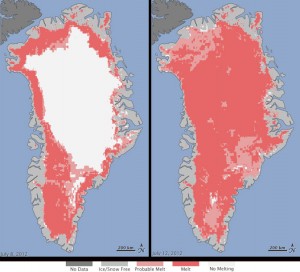
Greenland ice sheet surface melt – NASA
The accumulation of heat in Arctic waters also influences other frozen parts of the Arctic, such as glaciers and ice caps on Greenland and in the Canadian Archipelago. As there is less and less sea ice to act as a buffer, more energy can go into melting glaciers from below and warming the air above them. This has a marked effect on Greenland’s marine-terminating glaciers and the Greenland Ice Sheet. Not only are glaciers flowing faster towards sea, but there is also a rapid increase in the summer surface melt Greenland experiences, leading to accelerating mass loss from the Greenland Ice Sheet. As the Arctic warms, an increased contribution to sea level rise is inevitable.


